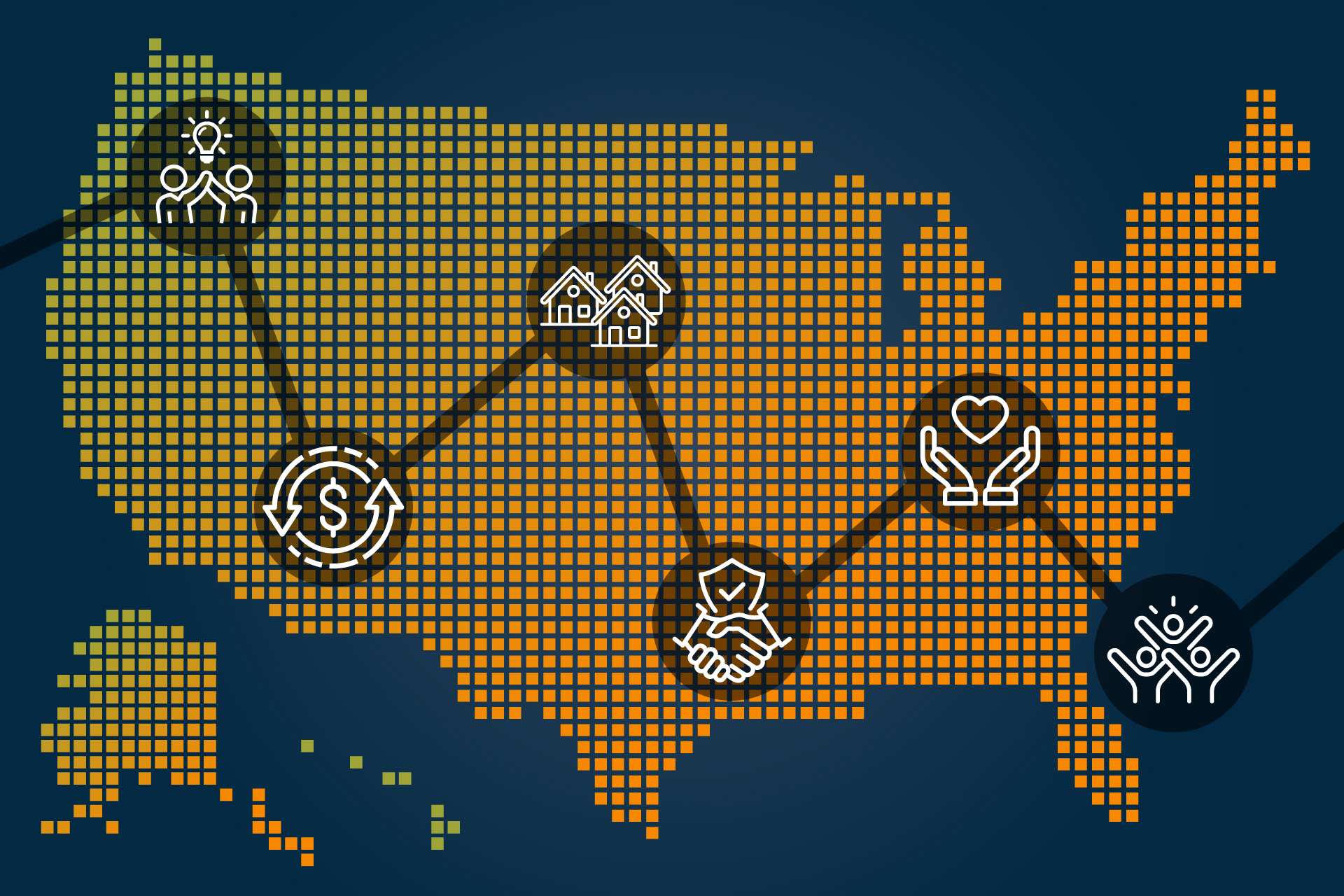Insights from the field—Health of entities serving low- and moderate-income communities


By Nishesh Chalise, Violeta Gutkowski, Steven Howland
August 28, 2024
Based on a national survey conducted by the Federal Reserve during April 2024, this two-part report provides an overview of economic conditions in low- and moderate-income (LMI) communities and among the entities serving them. This unique and timely information is intended to help equip decision-makers with key insights for developing approaches to foster economic security in LMI communities.
The first report addresses economic conditions in LMI communities, while this report focuses on the health of the organizations that work in them.
It is important to monitor the economic conditions faced by LMI populations; however, understanding the health of the entities serving them is also crucial. These entities provide vital services to LMI communities and are a critical part of the infrastructure that promotes economic resilience and mobility. Entities responding to the 2024 Community Perspectives Survey indicated that they were able to serve their communities well, but also that inflation and increased requests for services were putting pressure on their ability to fully meet demand.
Overall, entities responded positively in terms of their ability to serve their communities; however, they also reported considerable challenges. Compared with 2023, nearly 80% of entities reported an increase in demand for their services, and 84% reported increased expenses. Additionally, entities noted that funding and fundraising were their top challenge. These challenges have hampered entities’ ability to fully meet their demand for services, as only about a one-third of respondents reported being able to do so.
A majority of entities (61.4%) reported they were able to serve their communities well. Almost half of respondents indicated that their ability to provide services had improved since 2023, and 57.9% expected their ability to serve LMI communities to continue improving over the 12 months following the April 2024 survey (Figure 20).
a. April 2024 (N=777)
b. Expectations for the year ahead (N=775)
Top challenges that entities expected to affect their ability to provide services over the next year:1
In April 2024, almost 80.0% of respondents reported that demand for services had increased over the past year, with half of those stating that demand had increased significantly (Figure 21). Higher demand places additional pressure on entities’ ability to meet the needs of LMI communities. Figure 22 shows that only about one-third of respondents were able to meet most (75%-100%) of their demand in 2023 and 2024. Slightly over one-third (36.7%) expected to meet most of their demand in 2025. Respondents noted that they expected a combination of a lack of funding, an increase in demand, and a lack of staff and/or volunteers to have an adverse impact on their ability to meet demand going forward.
“Our funding does not keep up with the demand for services,” noted one respondent.
(N=753)
(N=750)
Top challenges that entities expected to affect their ability to meet demand for services over the next year:
When asked in April 2024 about their entity’s financial health, 40.6% of respondents described it as steady with no changes expected for the year ahead (Figure 23). Another 32.3% indicated that they were facing some stress and were trying to find efficiencies to save money. Only 9.1% of entities reported being under a lot of stress and having to cut positions or programs.
(N=750)
Changes in staffing levels over the 12 months preceding the April 2024 survey were mixed across respondents. Some entities (30.9%) reported an increase in their staffing levels, while others reported a decrease (29.3%) or no change (38.5%) (Figure 24).
(N=750)
Top challenges that entities expected to affect their staffing over the next year:
In April 2024, 84% of respondents indicated that their entities had experienced increased expenses over the past year (Figure 25).
(N=751)
Top challenges that entities expected to affect their expenses over the next year:
The results for changes in revenue compared with the 12 months preceding the April 2024 survey were mixed across respondents. Figure 26 shows that slightly over one-third of respondents indicated that revenue had increased, a little more than a quarter reported that revenue had remained unchanged, and about one-third reported that it had decreased.
(N=745)
Given that sources of revenue differ across entities, we asked survey respondents about their top three sources of revenue and changes in revenue from specific sources. Government funds represented the top source of revenue for 46% of respondents, followed by fees for services (16%) and foundation funds (10%).
The following section (Figures 27 to 32) highlights how revenue from six different sources changed over the past year. Note that only entities identifying a particular source of revenue as one of their top three sources were asked about changes in that source. For example, if an organization did not include government funds as one of its top three sources of revenue, then the organization was not asked about changes in government funds.
In general, entities that experienced an increase in revenue from one source also saw increases across multiple sources. Similarly, entities that experienced a decrease in revenue from one source also saw declines in multiple sources.
More entities reported an increase in revenue than entities reporting a decrease in revenue across all sources except donations. More than half of respondents for whom credit and loans were the top sources of revenue reported increased revenue from this source over the past year.
(N=497)
Revenue from government funds increased for 34.9% of respondents over the past year, while one-third reported a decline.
(N=288)
Revenue from fees for services increased for 37.2% of entities over the past year, while 38.2% reported no change.
(N=256)
Revenue from individual donations decreased for 42.5% of respondents over the past year, while it increased for 27.4% of respondents. Individual donations decreased for 55% of entities for which it was their top funding source.
(N=243)
Revenue from corporate donations decreased for 40% of respondents over the past year, while almost one-third did not see any changes.
(N=384)
Revenue from foundation funds increased for 34.3% of respondents relative to 2023, while 31.7% reported a decline. Foundation funds increased for 42% of entities for which it was their top funding source.
(N=99)
Revenue from credit and loans increased for 37.4% of respondents relative to 2023, while 29.3% reported a decline. Credit and loans increased for 51% of entities for which it was their top funding source.
| Does the entity you represent offer services directly to individuals and families? (N=1117) | |
|---|---|
| No | 14.0% |
| Unsure | 2.2% |
| Yes | 83.9% |
| To which type of geographic area does your entity dedicate the most resources? (N=1107) | |
| Equal across all geographic areas | 41.5% |
| Metropolitan | 40.0% |
| Rural (including frontier) | 18.5% |
| What type of geographic area does your entity serve? (N=737) | |
| Nationwide | 4.8% |
| Statewide or multiple states | 17.7% |
| Within a county or some counties within a state | 45.7% |
| Within a metropolitan statistical area (MSA) | 31.8% |
| Currently, is the entity you represent led by a person of color? (N=718) | |
| Yes | 40.7% |
| No | 56.3% |
| Unsure | 2.9% |
1. Percentages are the share of respondents ranking the item as the No. 1 factor. Overall ranking is based on a weighted ranking of the top three factors.
Starting in 2020, the Federal Reserve System began conducting surveys to better understand the range of challenges facing low- and moderate-income (LMI) communities as an effect of the COVID-19 pandemic. That collection of surveys was called “Perspectives from Main Street.”
While the United States is no longer amid a pandemic-induced public health and economic crisis, lower-income and under-resourced communities continue to face obstacles that may hinder their full participation in the economy. The need to better understand such challenges and those faced by entities serving these communities is still crucial. To that end, the Federal Reserve began implementing the Community Perspectives Survey in 2024.
The Community Perspectives Survey is a national survey aimed at reporting the economic conditions of LMI communities and the health of the entities that serve them. This survey has two objectives:
The survey was open from April 2 to May 3, 2024. Responses were collected through a convenience sampling method that relied on contact databases to identify representatives of nonprofit organizations, financial institutions, government agencies, and other community organizations. These representatives were invited to participate in the survey via emails, newsletters, and social media posts. The survey had a total of 937 responses from entities who serve LMI communities. However, the total number of responses across sectors could differ because not all entities provide services in each area asked about on the survey. Respondents were asked to select a topic area based on their entity’s top programming focus and answer questions related to that sector specifically and not others. All responses are from entities that serve LMI communities.
The views expressed in this report are those of the report team and do not necessarily represent the views of the Federal Reserve System.
Please cite this report as: Chalise, Nishesh, Violeta Gutkowski, and Steven Howland. “Community Perspectives Survey: Insights from the Field – Health of entities serving low- and moderate-income communities,” August 2024.
The Federal Reserve’s community development function seeks to promote the economic resilience and mobility of LMI and underserved households and communities across the United States. We thank the following survey team members for their contributions.
Daniel Paul Davis, Federal Reserve Bank of St. Louis
Michael Grover, Federal Reserve Bank of Minneapolis
David Kaufmann, Federal Reserve Board of Governors
Karen Leone de Nie, Federal Reserve Bank of Atlanta
Nishesh Chalise, Federal Reserve Bank of St. Louis
Surekha Carpenter, Federal Reserve Bank of Richmond
Violeta Gutkowski, Federal Reserve Bank of St. Louis
Steven Howland, Federal Reserve Bank of Kansas City
Heidi Kaplan, Federal Reserve Board of Governors
Matthew Klesta, Federal Reserve Bank of Cleveland
Lisa Nelson, Federal Reserve Bank of Cleveland
Whitney Felder, Fed Communities
Crystal Flynn, Fed Communities
Melissa Kueker, Federal Reserve Bank of St. Louis
Nicholas A. Ledden, Federal Reserve Bank of St. Louis
Derek Stacey, Federal Reserve Bank of Cleveland
Allyson M. Sykora, Federal Reserve Bank of St. Louis
Surekha Carpenter, Federal Reserve Bank of Richmond
Suzanne Cummings, Federal Reserve Bank of Boston
Michelle Dailey, Federal Reserve Bank of St. Louis
Molly Hubbert Doyle, Federal Reserve Bank of Dallas
Steven Howland, Federal Reserve Bank of Kansas City
Kellye Jackson, Federal Reserve Bank of New York
Heidi Kaplan, Federal Reserve Board of Governors
Elizabeth Kneebone, Federal Reserve Bank of San Francisco
Susan Longworth, Federal Reserve Bank of Chicago
Grace Meagher, Federal Reserve Bank of Atlanta
Edison Reyes, Federal Reserve Bank of New York
John Rees, Federal Reserve Bank of Atlanta
Brianna Smith, Federal Reserve Bank of Chicago

Industrial flex space has become a quiet favorite among sophisticated investors seeking durable income backed by real business demand. If...

Getting an inheritance is the epitome of a mixed blessing. You receive a financial windfall, but the cause is the...

During his tenure as the California Secretary of Health and Human Services, Mike Wilkening cemented his reputation as a steady...